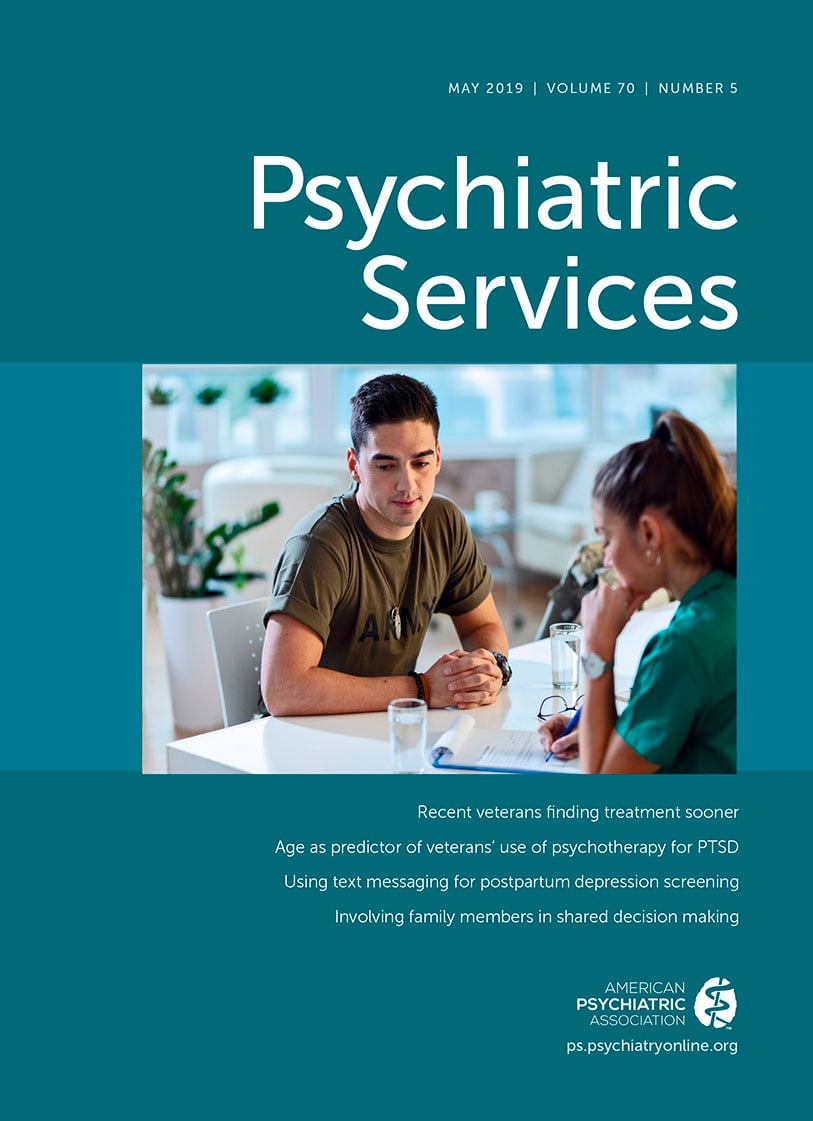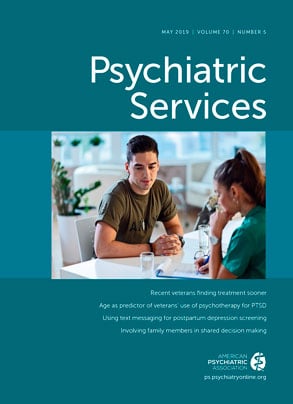Physician burnout, a term used to describe the consequences of increased workplace-related stress or exhaustion, has emerged as a major issue, with increasing studies reporting concerning findings (
1). The 2018 Medscape National Physician Burnout and Depression Report revealed worrying rates of physician burnout (42%) and depression (15%) (
2). Additionally, a recent review in the
Journal of the American Medical Association showed considerable variability in measures of physician burnout, with estimates ranging from 0% to as high as 80.5% (
1). Although some studies reported that, compared with other physicians, psychiatrists generally experienced lower burnout rates, improved work-life balance, and greater satisfaction, psychiatrists are not immune to burnout (
3). This issue has become of grave concern at a national level and across different health care settings, leading the American Psychiatric Association (APA) to identify physician burnout and well-being as a main priority (
4).
Telepsychiatry is defined as the provision of psychiatric services remotely through various technological communication platforms (
5). Recently, the field of telepsychiatry has significantly expanded, with increased adoption due to increased bandwidth, expanded Internet access, improved reimbursement models, and greater acceptance from patients (
6). However, the literature examining the overall effect of telepsychiatry on psychiatrist well-being and burnout is still lacking (
5). This Open Forum explores the potential benefits and challenges of telepsychiatry with regard to psychiatrist burnout and discusses approaches to enhance these benefits, while mitigating potential challenges.
Burnout Factors and Coping Mechanisms
Physician burnout is defined as a psychological syndrome affecting those in medical practice settings that may be characterized by heightened emotional exhaustion, increased cynicism, and a decreased sense of fulfillment from work (
3). While physician burnout is likely multifactorial, rigorous career demands, coupled with inadequate resources, appear to be a strong predictor of burnout (
7,
8). The primary stressors identified for psychiatrists include intensified emotional labor with patients; changing models of service delivery; discrepancy between training and practice postresidency; and inadequate resources for addressing complex administrative and legal aspects, such as staying current on changing institutional and state-specific regulations or managing the high volume of paperwork associated with insurance claims (
8,
9). Other reported factors include reduced time with patients in favor of administrative tasks, increased emphasis on productivity, perception of unfair treatment by supervisors, and being on call frequently (
7). Additionally, predictors of occupational cynicism include the lack of protected time outside of the scope of patient care, the perception that patients are not improving, and the lack of a coherent team (
7).
The approaches through which psychiatrists manage stress significantly affect the extent to which they may experience burnout. Innovative approaches to address burnout, improve resilience, and enhance psychiatrist well-being involve programs aimed at improving psychiatrists’ sense of control over their practice and schedule (
8). Other recommendations include establishing strong interpersonal support networks, whether through personal relationships with family, partners, or friends or through group settings, such as community groups and professional organizations (
8). Some reports support the use of mindfulness to enhance empathy and regain a sense of meaning vis-a-vis medical practice (
8).
Telepsychiatry and Burnout
Although research regarding a psychiatrist’s decision to pursue telepsychiatry is quite limited, studies on telecommuting and other forms of telemedicine identify several factors that may inform this choice, including improved productivity, increased flexibility for work-life balance, and greater job satisfaction (
10,
11). Thus, understanding how these factors relate to the field of psychiatry may help elucidate the potential role of telepsychiatry in mitigating burnout and enhancing psychiatrist well-being (
8,
10,
11). One possible way telepsychiatry may reduce burnout is through creating an increased sense of control over the psychiatrist’s schedule. For example, telepsychiatry eliminates the need to commute to an office or health care facility as well as the need to travel between practice locations. This lack of commute may free up more time for sleep, self-care, family time, and social events, all of which have been shown to greatly decrease the risk of burnout (
9). Alternatively, with increasing pressures to see patients over shorter sessions, telepsychiatrists may choose to use the time that otherwise would be spent commuting for documentation and other administrative tasks, potentially alleviating some of the ongoing stress associated with patient care.
Additionally, telepsychiatry may offer safety benefits through decreasing certain risks of practicing that can be stressful and contribute to burnout. Through its remote nature, videoconferencing reduces some of the occupational hazards associated with practicing psychiatry, such as dangers presented by violent or agitated patients and difficulty fully detaching oneself from the emotional stress of in-person patient encounters (
9). Telepsychiatry may also alleviate burnout among in-person providers, given that telepsychiatrists could serve as backup to those working in crisis prevention or emergency behavioral health settings (
9,
12).
Despite these potential benefits, telepsychiatrists also face some notable challenges as telecommuters, including risk of social and professional isolation, difficulty fully separating work from home, a possible sense of alienation from the physical workplace, and a potential increase in household responsibilities when working from home (
10). This sense of professional isolation may develop through difficulty in interfacing with other psychiatrists and behavioral health professionals or difficulty in adjusting to the nature of virtual patient interactions. Social isolation may also develop from the general lack of human contact or opportunities to socialize in one’s direct workspace compared with an office or health care facility (
10). Thus, while telepsychiatrists still provide clinical services and interact remotely with patients or support staff, they may experience social and professional isolation, particularly if providing care remotely on a full-time basis.
Telepsychiatry may also contribute to a more sedentary lifestyle by minimizing the need for changing location or position and for commuting to work. While little is known about the occupational effects of telepsychiatry on the health and well-being of psychiatrists, the literature demonstrates notable correlations between increased sedentary behavior and reported levels of burnout as well as the increased risk of developing obesity, type II diabetes, cardiovascular disease, and cancer (
13). Other concerns for telepsychiatrists include blurring the separation of work from home life and possible pressure to work longer hours or check e-mail after hours (
10).
Current Initiatives to Address Burnout
In response to emerging evidence on the alarming prevalence of physician burnout, numerous professional associations have launched initiatives aimed at combating the problem, including the expansion of resources related to telepsychiatry. The APA has led the effort to expand telepsychiatry in hopes that it will not only improve patient access to and satisfaction with mental health services but also give providers increased flexibility in their practice (
4,
14). Those efforts have included establishing the APA Committee on Telepsychiatry in 2015, creating a telepsychiatry toolkit aimed at educating and orienting clinicians on implementation of telepsychiatry in their practice, and developing a guide for streamlining telepsychiatry implementation in medical care contexts (
14). The National Academy of Medicine (NAM) has also taken innovative steps to address physician burnout through expanding access to effective telehealth tools and investing in educational resources on prioritizing physician well-being (
15). Together, these initiatives by key influencers like the APA and NAM represent a general trend toward extending the advantages already seen from telehealth to the goal of reducing physician burnout.
Implications for Psychiatrists
Given the anticipated increase in adoption of telepsychiatry, it is important to balance the capacity of telepsychiatry to enhance well-being, while working to overcome the occupational challenges it may present. Accordingly, recommendations include the following:
•
Establish and communicate expectations and boundaries with the workplace regarding work hours, availability, and responsiveness, particularly after hours and on weekends (
10).
•
Establish clear personal boundaries with friends and family regarding schedules, the distinction between work and home lives, and household responsibilities (
10).
•
Use telepsychiatry models that incorporate interaction between remote and in-person staff, such as the integrated or collaborative care models. These models may help to mitigate potential occupational, social, and academic isolation.
•
Actively plan social activities to avoid social isolation. Moreover, engage in activities beyond work, such as personal interests and hobbies (
9).
•
Schedule regular exercise sessions to maintain a healthier lifestyle. Furthermore, invest in office furniture that provides back support and proper ergonomic positioning of the desk, computer, and monitor.
•
Diversify the type of work through participation in a mix of direct patient care and consultation services, academia, or research (
9). Psychiatrists may incorporate a combination of telepsychiatry and in-person psychiatry as a way to capitalize on the convenience and flexibility of videoconferencing while avoiding isolation.
•
Make use of the resources available on physician burnout and well-being, including those created by professional associations, such as the APA and NAM (
4,
14,
15).
•
Remain cognizant of one’s own mental health needs. Psychiatrists experiencing burnout or excessive stress are encouraged to prioritize self-care and seek mental health care.
As stress and burnout continue to be major issues affecting the quality of life and well-being of physicians, we must closely examine the factors contributing to burnout as well as potential protective factors that may mitigate these trends toward physician burnout. This Open Forum illustrates that more research is needed to examine the specific role that innovative tools like telepsychiatry may play in influencing the health and well-being of psychiatrists. Such research would need to examine the factors that may moderate the occupational benefits and drawbacks of telepsychiatry in order to best assist in developing workplace cultures and virtual work environments that champion physician well-being.

